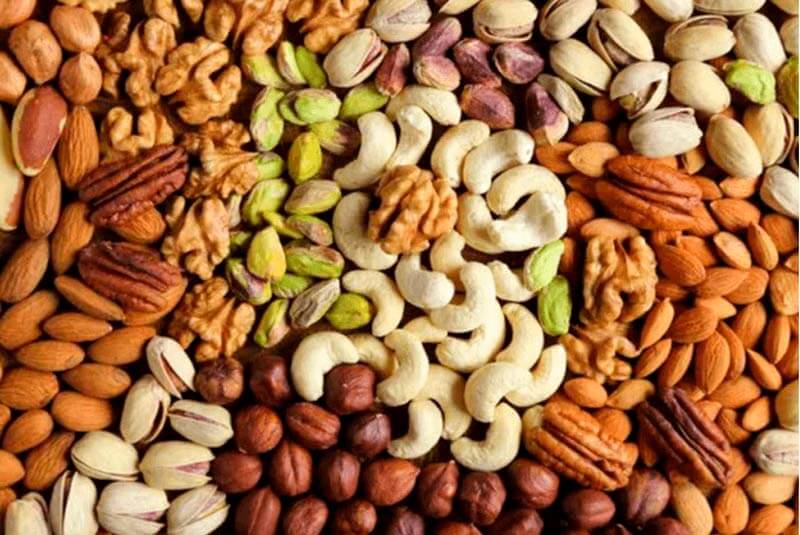Recommendations for drying and storing nuts to maintain their quality and main advantages of using steel silos.
The world production of almonds, hazelnuts, walnuts and pistachios has increased notably in the last thirty years. Scientific evidence on its health benefits is increasingly proven and it is a decisive factor in increasing its consumption worldwide.
On the other hand, its particular composition and varied use creates a high technological interest. The innovation and introduction of new products derived from nuts in the international market is led by the European market.
Nut quality
The quality standards required by the food industry make it increasingly important to obtain a healthy product, with a good taste and attractive to the eye. This is made possible by fine-tuning of handling during cultivation, harvesting, conditioning and storage.
Given that each type of nut has a different technological process, it is necessary to consider specific qualitative aspects for each case.
For the optimal maintenance of the product after harvest, special emphasis must be placed on the drying and storage processes, which are the most important and possibly the most delicate in handling nuts, their quality and their value in the market will depend on this.
Post-harvest conditioning
This is the initial stage in the commercial life of nuts. Once harvested, they must be properly conditioned pursuing the same objective: “Preserve quality”, which involves various operations to remove remains of leaves, branches, stones and dust, as well as separate the outer skin in some cases.
Empty fruits are also usually separated at this stage. Once the nuts are separated, they must be stabilized, since they are marketed for long periods of time.
Drying
Next, it is very important to dry them to remove moisture content. Both walnuts and hazelnuts, at the time of harvest, have more than 20% humidity and thus it is not possible to carry out a good conservation. For this reason, the humidity should be lowered to a percentage close to 8-10%. The objective is predominantly to reduce the risk of fungal development and oxidation.
When the volume of the harvest is large, it is advisable to dry the nuts industrially. The use of dryers helps to reduce the humidity and water content of the product to levels that limit the growth of microorganisms and they are kept in silos that avoid temperature increases as much as possible.
It is also important to take into account the variety of nuts to dry, since each type has its own characteristics, size, sensitivity to rancidity and darkening.
Storage
Once the nuts are dry, they must be stored in optimal conditions of temperature and humidity. In the case of almonds and hazelnuts, the relative humidity must be below 65% with a temperature between 10ºC and 15ºC.
If we do not take the appropriate measures we risk the appearance of worms or fungi, which could endanger the entire harvest. Aspergillus spp is a cosmopolitan fungus that can quickly colonize large numbers of improperly drying almonds. This fungus produces aflatoxins, a substance that is hazardous to health.
Food safety
The quality aspect is especially relevant in the case of nuts. Therefore, the residues of phytosanitary products should be considered, since they represent an important barrier to export in some markets.
On the other hand, the presence of mycotoxins is another fundamental aspect in the nuts sector, as we have seen previously they create suitable conditions for the development of mycotoxin producing microorganisms, especially from the aflatoxin group. The fact that some nuts are harvested directly from the ground increases the risk of external microbial contamination.
Advantages of drying and storing nuts in silos
At Silos Spain we have always innovated and developed new systems to help obtain the best product quality and the optimal maintenance after harvest.
Drying silo
After years of experience in the nuts sector, we can assure that drying nuts in a silo is one of the most efficient systems available today.
If we compare it with sun-drying or with drying in a warehouse, there is a qualitative jump.
- No need for large spaces or a large workforce (a single person can manage a drying and storage plant).
- A more efficient control process without consideration of outside weather influences.
- By having a constant heat input, drying is fast enough to avoid product contamination and it guarantees storage in the best conditions.
Operating example of the drying silo for almonds
To get the best performance from our drying silo we need to adjust the dimensions according to the peeling production capacity of the plant. The drying silo is a hopper silo on a metal structure with a 45º cone.
Inside, there is a slide to prevent the almond from breaking during free fall and a fully perforated counter-cone with a connection for air entrance. The counter-cone also allows the discharge of the product according to the FIFO method (first in, first out).
A centrifugal fan connected to a hot air generator is attached to the connecting tube. This hot air passes through the counter-cone drying the almonds.
An air extractor is incorporated in the ceiling to prevent internal condensation and remove excess hot air.
The drying time is somewhat relative, since it will depend on the input humidity of the product, and can range between 8 to 10 hours.
Silo for the storage of nuts
The silo is undoubtedly the best option for the storage of nuts due to the advantages it provides for their conservation and handling .
- It allows easy ventilation and temperature control if necessary (it is much more complex and expensive to do it in a warehouse).
- Its implementation requires a much smaller space than other storage systems.
- There are no product losses due to breakage, rodents, etc.
- The quality of the product is always assured for its subsequent sale and handling.
- The handling and labor cost is lower than conventional warehouses.
A silo is a good investment if our goal is to have a good product to meet the quality standards demanded by the market.



